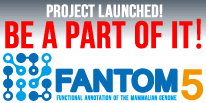| Go to current FANTOM site | |||||||||||
 |
|||||||||||
|
|
Welcome to FANTOM Functional Annotation of the Mammalian Genome
In FANTOM4 the focus has changed to understanding how these components work together in the context of a biological network. Using deepCAGE (deep sequencing with CAGE) we monitored the dynamics of transcription start site (TSS) usage during a time course of monocytic differentiation in the acute myeloid leukemia cell line THP-1. This allowed us to identify active promoters, monitor their relative expression and define relevant regions for carrying out transcription factor binding site predictions. Computational methods were then used to build a network model of gene expression in this leukemia and the transcription factors key to its regulation. This work gives the first picture of the wiring between genes involved in acute myeloid leukemia and provides a strategy for identifying key factors that determine cell fates. Tools Genome Browser: graphical display of genomic features, such as promoters, exon structures, H3K9 acetylation, transcription factors positioning on the genome, coupled with gene and promoter activities.
SwissRegulon: FANTOM4 TF regulation is predicted using Motif Activity Response Analysis (MARA) developed by Erik van Nimwegen at Biozentrum. Follow the link to carry out MARA on your own dataset. Custom Tracks on the UCSC Genome Browser: FANTOM4 tracks on the UCSC Genome Browser Database. The RIKEN integrated database of mammals: Integration of FANTOM4 data with other mammalian resources, in particular, produced by RIKEN. Contacts 
|
Citeulike

Connotea

Del.icio.us

Digg


| 2010/12/10 |
| 2010/05/31 |
|
A new FANTOM4 satellite paper has been published:
≫ details |
| 2010/03/05 |
|
A new FANTOM4 satellite paper has been published:
≫ details |
| 2010/01/05 |
|
A new FANTOM4 satellite paper has been published:
≫ details |
| 2009/12/10 |
|
A new FANTOM4 satellite paper has been published:
≫ details |









